Open-Source Design and Economics of Manual Variable-Tilt Angle DIY Wood-Based Solar Photovoltaic Racking System
Abstract
:1. Introduction
2. Materials and Methods
2.1. Material Properties
2.2. Material Stability
2.3. Energy and Economic Analysis
2.4. Design Analysis Assumptions
3. Results
3.1. Bill of Materials
3.2. Variable Angle Installation Instructions
3.3. Build Time
3.4. Energy Simulation Results
3.5. Economic Analysis Results
4. Discussion
4.1. Wooden Racking for Agrivoltaic and Impact of Labor Cost
4.2. Agrivoltaics
4.3. System Location Sensitivity
4.4. Wood Price Sensitivity
4.5. Limitations
5. Conclusions
Author Contributions
Funding
Institutional Review Board Statement
Informed Consent Statement
Data Availability Statement
Acknowledgments
Conflicts of Interest
Appendix A. Variable Tilt System Structural Analysis



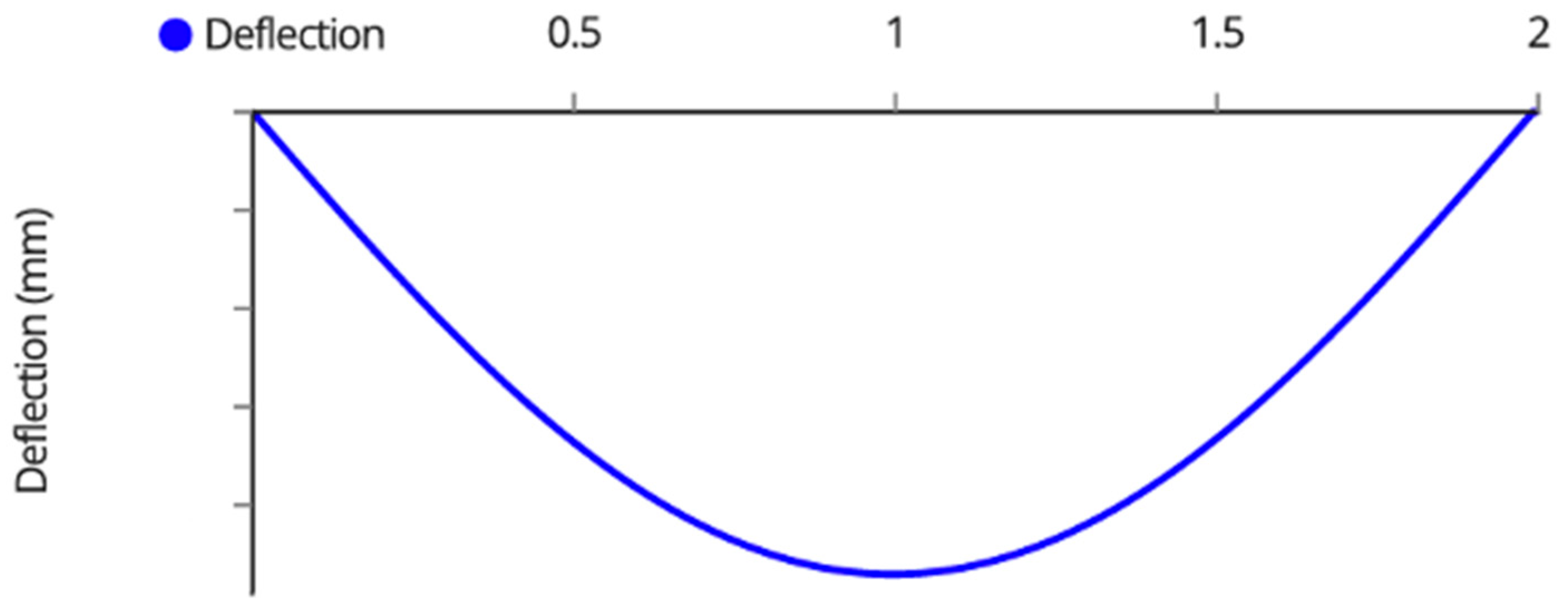

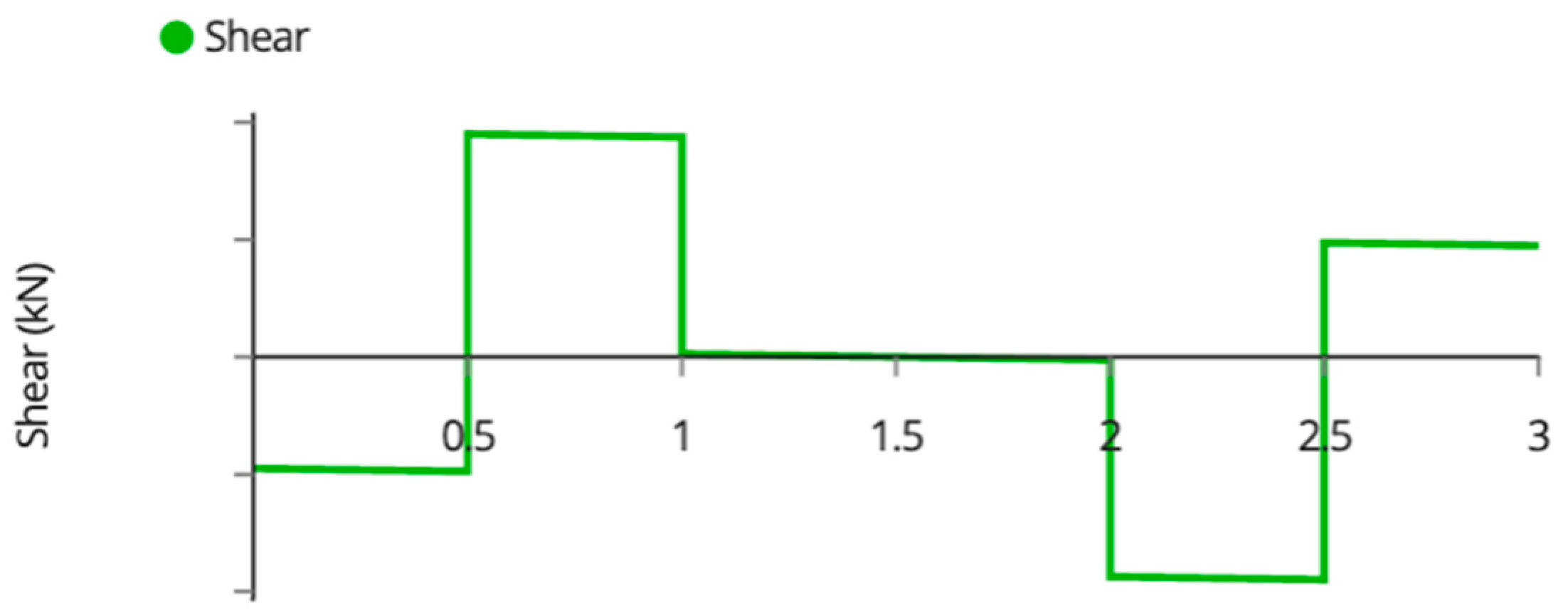






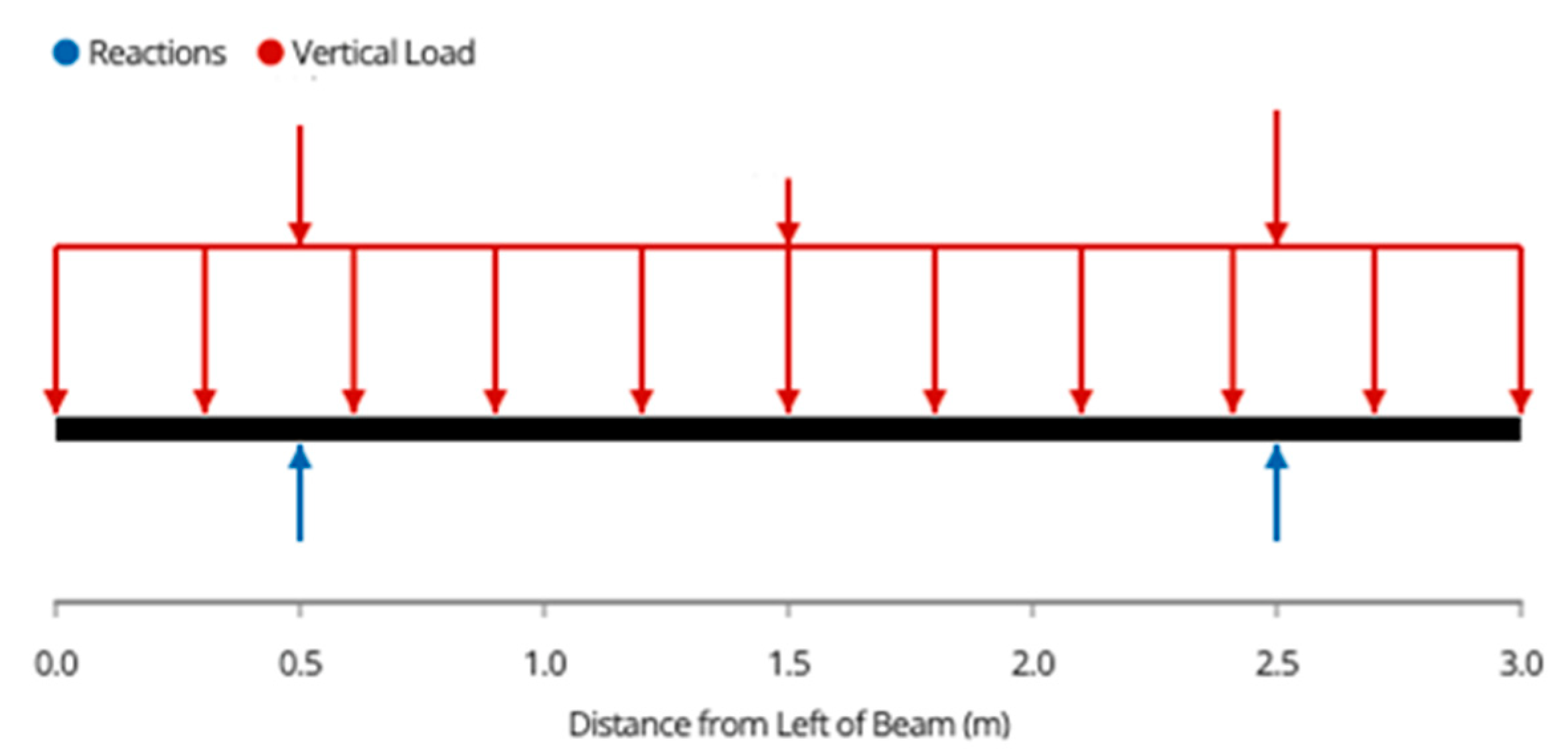



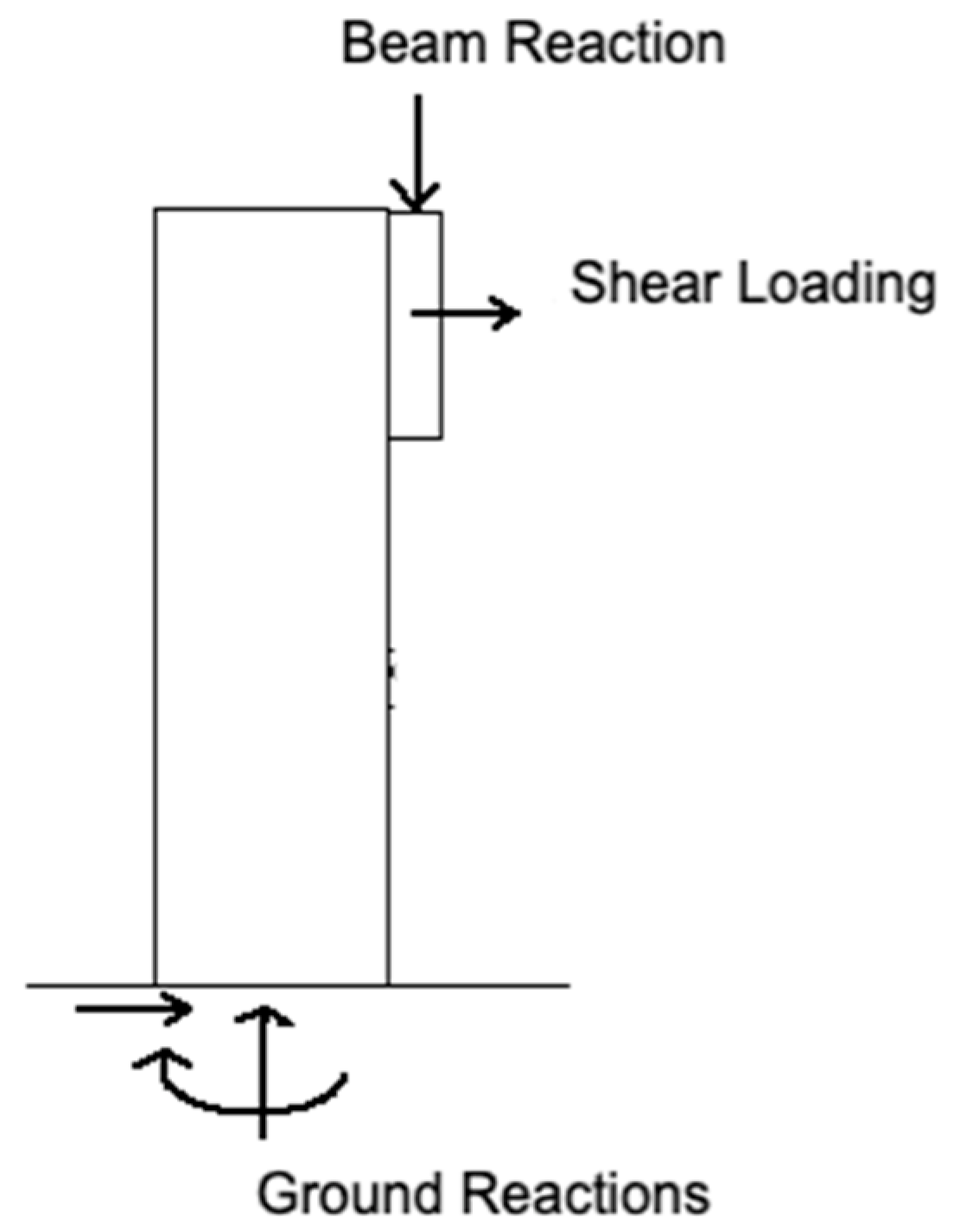



References
- Pearce, J.M. Photovoltaics—A path to sustainable futures. Futures 2002, 34, 663–674. [Google Scholar] [CrossRef]
- Fu, R.; Feldman, D.J.; Margolis, R.M. US Solar Photovoltaic System Cost Benchmark: Q1 2018; No. NREL/TP-6A20-72399; National Renewable Energy Lab.: Golden, CO, USA, 2018. [Google Scholar]
- How Much Do Solar Panels Cost? 2022 Guide. Available online: https://news.energysage.com/how-much-does-the-average-solar-panel-installation-cost-in-the-u-s/ (accessed on 10 May 2022).
- Branker, K.; Pathak, M.J.M.; Pearce, J.M. A review of solar photovoltaic levelized cost of electricity. Renew. Sustain. Energy Rev. 2011, 15, 4470–4482. [Google Scholar] [CrossRef] [Green Version]
- Dudley, D. Renewable Energy Will Be Consistently Cheaper Than Fossil Fuels by 2020, Report Claims [WWW Document]. Forbes. 2019. Available online: https://www.forbes.com/sites/dominicdudley/2018/01/13/renewable-energy-cost-effective-fossil-fuels-2020/ (accessed on 13 April 2020).
- Solar Industry Research Data. Available online: https://www.seia.org/solar-industry-research-data (accessed on 13 April 2020).
- Vaughan, A. Time to shine: Solar power is fastest-growing source of new energy. The Guardian, 6 October 2017. [Google Scholar]
- Barbose, G.L.; Darghouth, N.R.; LaCommare, K.H.; Millstein, D.; Rand, J. Tracking the Sun: Installed Price Trends for Distributed Photovoltaic Systems in the United States-2018; Berkeley Lab: Berkely, CA, USA, 2018. [Google Scholar]
- IEA. Solar PV—Renewables 2020—Analysis. Available online: https://www.iea.org/reports/renewables-2020/solar-pv (accessed on 7 April 2022).
- Levin, T.; Thomas, V.M. Can developing countries leapfrog the centralized electrification paradigm? Energy Sustain. Dev. 2016, 31, 97–107. [Google Scholar] [CrossRef] [Green Version]
- Lang, T.; Ammann, D.; Girod, B. Profitability in absence of subsidies: A techno-economic analysis of rooftop photovoltaic self-consumption in residential and commercial buildings. Renew. Energy 2016, 87, 77–87. [Google Scholar] [CrossRef]
- Hayibo, K.S.; Pearce, J.M. A Review of the Value of Solar Methodology with a Case Study of the U.S. VOS. Renew. Sustain. Energy Rev. 2021, 137, 110599. [Google Scholar] [CrossRef]
- Agenbroad, J.; Carlin, K.; Ernst, K.; Doig, S. Minigrids in the Money: Six Ways to Reduce Minigrid Costs by 60% for Rural Electrification. Rocky Mountain Institute. 2018. Available online: https://rmi.org/insight/minigrids-money/ (accessed on 28 February 2022).
- Alafita, T.; Pearce, J.M. Securitization of residential solar photovoltaic assets: Costs, risks and uncertainty. Energy Policy 2014, 67, 488–498. [Google Scholar] [CrossRef] [Green Version]
- Renewables International. Photovoltaics after Grid Parity Plug-and-Play PV: The Controversy 2013. Renewables. 2013. Available online: http://www.renewablesinternational.net/plug-and-play-pv-the-controversy/150/452/72715/ (accessed on 18 December 2015).
- Mundada, A.S.; Nilsiam, Y.; Pearce, J.M. A review of technical requirements for plug-and-play solar photovoltaic microinverter systems in the United States. Solar Energy 2016, 135, 455–470. [Google Scholar] [CrossRef]
- Grafman, L.; Pearce, J.M. To Catch the Sun; Humboldt State University Press: Arcata, CA, USA, 2021; ISBN 978-1-947112-62-9. [Google Scholar]
- Barbose, G.; Darghouth, N.; Millstein, D.; Cates, S.; DiSanti, N.; Widiss, R. Tracking the Sun IX: The Installed Price of Residential and Non-Residential Photovoltaic Systems in the United States; Lawrence Berkeley National Lab. (LBNL): Berkeley, CA, USA, 2016. Available online: https://www.osti.gov/servlets/purl/1345194 (accessed on 10 May 2022).
- Khan, M.T.A.; Norris, G.; Chattopadhyay, R.; Husain, I.; Bhattacharya, S. Autoinspection and Permitting with a PV Utility Interface (PUI) for Residential Plug-and-Play Solar Photovoltaic Unit. IEEE Trans. Ind. Appl. 2017, 53, 1337–1346. [Google Scholar] [CrossRef]
- Khan, M.T.A.; Husain, I.; Lubkeman, D. Power electronic components and system installation for plug-and-play residential solar PV. In Proceedings of the 2014 IEEE Energy Conversion Congress and Exposition (ECCE), Pittsburgh, PA, USA, 14–18 September 2014; pp. 3272–3278. [Google Scholar]
- Lundstrom, B.R. Plug and Play Solar Power: Simplifying the Integration of Solar Energy in Hybrid Applications; Cooperative Research and Development Final Report; CRADA Number CRD-13-523; National Renewable Energy Lab. (NREL): Golden, CO, USA, 2017. [Google Scholar]
- Mundada, A.S.; Prehoda, E.W.; Pearce, J.M. U.S. market for solar photovoltaic plug-and-play systems. Renew. Energy 2017, 103, 255–264. [Google Scholar] [CrossRef] [Green Version]
- Fthenakis, V.; Alsema, E. Photovoltaics energy payback times, greenhouse gas emissions and external costs: 2004–early 2005 status. Prog. Photovolt. Res. Appl. 2006, 14, 275–280. [Google Scholar] [CrossRef] [Green Version]
- Feldman, D.; Barbose, G.; Margolis, R.; Bolinger, M.; Chung, D.; Fu, R.; Seel, J.; Davidson, C.; Darghouth, N.; Wiser, R. Photovoltaic System Pricing Trends: Historical, Recent, and Near-Term Projections 2015; NREL: Golden, CO, USA, 2015. [Google Scholar]
- Feldman, D.; Barbose, G.; Margolis, R.; Wiser, R.; Darghout, N.; Goodrich, A. Photovoltaic (PV) Pricing Trends: Historical, Recent, and Near-Term Projections, Sunshot; NREL: Golden, CO, USA, 2012. [Google Scholar]
- PVinsights. PVinsights 2022. Available online: http://pvinsights.com/ (accessed on 16 January 2022).
- Alt E Store. Tamarack Solar Top of Pole Mounts for Large Solar Panels. Available online: https://www.altestore.com/store/solar-panel-mounts/top-of-pole-solar-panel-mounts/tamarack-solar-top-of-pole-mounts-6072-cell-solar-panels-p40745/ (accessed on 16 January 2022).
- TPM3 Pole Mount for Three 60/72 Cell Solar Modules. Available online: https://www.off-the-grid-solar.com/products/tpm3-pole-mount-for-three-60-72-cell-solar-modules (accessed on 10 March 2022).
- Wittbrodt, B.; Laureto, J.; Tymrak, B.; Pearce, J.M. Distributed Manufacturing with 3-D Printing: A Case Study of Recreational Vehicle Solar Photovoltaic Mounting Systems. J. Frugal Innov. 2015, 1, 1. [Google Scholar] [CrossRef] [Green Version]
- Wittbrodt, B.T.; Pearce, J.M. Total U.S. Cost Evaluation of Low-Weight Tension-Based Photovoltaic Flat-Roof Mounted Racking. Solar Energy 2015, 117, 89–98. [Google Scholar] [CrossRef] [Green Version]
- Wittbrodt, B.; Pearce, J.M. 3-D Printing Solar Photovoltaic Racking in Developing World. Energy Sustain. Dev. 2017, 36, 1–5. [Google Scholar] [CrossRef] [Green Version]
- Arefeen, S.; Dallas, T. Low-Cost Racking for Solar Photovoltaic Systems with Renewable Tensegrity Structures. Solar Energy 2021, 224, 798–807. [Google Scholar] [CrossRef]
- Pearce, J.M.; Meldrum, J.; Osborne, N. Design of Post-Consumer Modification of Standard Solar Modules to Form Large-Area Building-Integrated Photovoltaic Roof Slates. Designs 2017, 1, 9. [Google Scholar] [CrossRef] [Green Version]
- Fixr. 2022 Solar Panel Maintenance Costs. Solar PV Maintenance Cost. Available online: https://www.fixr.com/costs/solar-panel-maintenance (accessed on 26 April 2022).
- Lubitz, W.D. Effect of Manual Tilt Adjustments on Incident Irradiance on Fixed and Tracking Solar Panels. Appl. Energy 2011, 88, 1710–1719. [Google Scholar] [CrossRef]
- Vandewetering, N.; Hayibo, K.S.; Pearce, J.M. Impacts of Location on Designs of DIY Low-Cost Fixed-Tilt Open Source Wood Solar Photovoltaic Racking. Designs 2022, 6, 41. [Google Scholar] [CrossRef]
- What You Need to Know about Pressure Treated Wood. Available online: https://www.lumber.com/blog/what-you-need-to-know-about-pressure-treated-wood (accessed on 17 February 2022).
- Gilman, P. SAM Photovoltaic Model Technical Reference; NREL/TP-6A20-64102; National Renewable Energy Lab. (NREL): Golden, CO, USA, 2015; p. 63. [Google Scholar] [CrossRef] [Green Version]
- System Advisor Model (SAM); National Renewable Energy Laboratory: Golden, CO, USA, 2022; Available online: https://github.com/NREL/SAM (accessed on 10 May 2022).
- Canada, N.R.C. National Building Code of Canada 2015. Available online: https://nrc.canada.ca/en/certifications-evaluations-standards/codes-canada/codes-canada-publications/national-building-code-canada-2015 (accessed on 17 February 2022).
- Pawluk, R.E.; Chen, Y.; She, Y. Photovoltaic Electricity Generation Loss Due to Snow—A Literature Review on Influence Factors, Estimation, and Mitigation. Renew. Sustain. Energy Rev. 2019, 107, 171–182. [Google Scholar] [CrossRef]
- Andrews, R.W.; Pollard, A.; Pearce, J.M. The Effects of Snowfall on Solar Photovoltaic Performance. Solar Energy 2013, 92, 84–97. [Google Scholar] [CrossRef] [Green Version]
- Andrews, R.W.; Pearce, J.M. Prediction of Energy Effects on Photovoltaic Systems Due to Snowfall Events. In Proceedings of the 2012 38th IEEE Photovoltaic Specialists Conference, Austin, TX, USA, 3–8 June 2012; pp. 3386–3391. [Google Scholar]
- Hayibo, K.S.; Petsiuk, A.; Mayville, P.; Brown, L.; Pearce, J.M. Monofacial vs Bifacial Solar Photovoltaic Systems in Snowy Environments. Renew. Energy 2022, 193, 657–668. [Google Scholar] [CrossRef]
- Ryan, A.; Williams Daniel, J.; Lizzadro-McPherson, J.; Pearce, M. The Impact of Snow Losses on Solar Photovoltaic Systems in North America in the Future. to be published.
- Trifecta 3-Panel Ground Mount KitDefault Title. Available online: https://www.thecabindepot.ca/products/trifecta-3-panel-ground-mount-kit (accessed on 22 April 2022).
- Retail Council of Canada Minimum Wage by Province. Retail Council of Canada 2022. Available online: https://www.retailcouncil.org/resources/quick-facts/minimum-wage-by-province (accessed on 10 May 2022).
- Mamun, M.A.A.; Dargusch, P.; Wadley, D.; Zulkarnain, N.A.; Aziz, A.A. A Review of Research on Agrivoltaic Systems. Renew. Sustain. Energy Rev. 2022, 161, 112351. [Google Scholar] [CrossRef]
- Mavani, D.D.; Chauhan, P.M.; Joshi, V. Beauty of Agrivoltaic System regarding double utilization of same piece of land for Generation of Electricity & Food Production. Int. J. Sci. Eng. Res. 2019, 10, 118–148. [Google Scholar]
- Pearce, J.M. Agrivoltaics in Ontario Canada: Promise and Policy. Sustainability 2022, 14, 3037. [Google Scholar] [CrossRef]
- Fthenakis, V.M.; Kim, H.C.; Alsema, E. Emissions from Photovoltaic Life Cycles. Environ. Sci. Technol. 2008, 42, 2168–2174. [Google Scholar] [CrossRef] [Green Version]
- Marrou, H.; Wery, J.; Dufour, L.; Dupraz, C. Productivity and radiation use efficiency of lettuces grown in the partial shade of photovoltaic panels. Eur. J. Agron. 2013, 44, 54–66. [Google Scholar] [CrossRef]
- Valle, B.; Simonneau, T.; Sourd, F.; Pechier, P.; Hamard, P.; Frisson, T.; Ryckewaert, M.; Christophe, A. Increasing the Total Productivity of a Land by Combining Mobile Photovoltaic Panels and Food Crops. Appl. Energy 2017, 206, 1495–1507. [Google Scholar] [CrossRef]
- Barron-Gafford, G.A.; Pavao-Zuckerman, M.A.; Minor, R.L.; Sutter, L.F.; Barnett-Moreno, I.; Blackett, D.T.; Thompson, M.; Dimond, K.; Gerlak, A.K.; Nabhan, G.P.; et al. Agrivoltaics Provide Mutual Benefits across the Food–Energy–Water Nexus in Drylands. Nat. Sustain. 2019, 2, 848–855. [Google Scholar] [CrossRef]
- Hudelson, T.; Lieth, J.H. Crop Production in Partial Shade of Solar Photovoltaic Panels on Trackers. AIP Conf. Proc. 2021, 2361, 080001. [Google Scholar] [CrossRef]
- Sekiyama, T. Performance of Agrivoltaic Systems for Shade-Intolerant Crops: Land for Both Food and Clean Energy Production. Master’s Thesis, Harvard Extension School, Cambridge, MA, USA, 2019. [Google Scholar]
- Trommsdorff, M.; Kang, J.; Reise, C.; Schindele, S.; Bopp, G.; Ehmann, A.; Weselek, A.; Högy, P.; Obergfell, T. Combining Food and Energy Production: Design of an Agrivoltaic System Applied in Arable and Vegetable Farming in Germany. Renew. Sustain. Energy Rev. 2021, 140, 110694. [Google Scholar] [CrossRef]
- Adeh, E.H.; Selker, J.S.; Higgins, C.W. Remarkable Agrivoltaic Influence on Soil Moisture, Micrometeorology and Water-Use Efficiency. PLoS ONE 2018, 13, e0203256. [Google Scholar] [CrossRef] [Green Version]
- Dupraz, C.; Marrou, H.; Talbot, G.; Dufour, L.; Nogier, A.; Ferard, Y. Combining Solar Photovoltaic Panels and Food Crops for Optimising Land Use: Towards New Agrivoltaic Schemes. Renew. Energy 2011, 36, 2725–2732. [Google Scholar] [CrossRef]
- Schindele, S.; Trommsdorff, M.; Schlaak, A.; Obergfell, T.; Bopp, G.; Reise, C.; Braun, C.; Weselek, A.; Bauerle, A.; Högy, P.; et al. Implementation of Agrophotovoltaics: Techno-Economic Analysis of the Price-Performance Ratio and Its Policy Implications. Appl. Energy 2020, 265, 114737. [Google Scholar] [CrossRef]
- Mow, B. Solar Sheep and Voltaic Veggies: Uniting Solar Power and Agriculture|State, Local, and Tribal Governments|NREL [WWW Document]. 2018. Available online: https://www.nrel.gov/state-local-tribal/blog/posts/solar-sheep-and-voltaic-veggies-uniting-solar-power-and-agriculture.html (accessed on 2 July 2020).
- Adeh, E.H.; Good, S.P.; Calaf, M. Solar PV Power Potential is Greatest Over Croplands. Sci. Rep. 2019, 9, 11442. [Google Scholar] [CrossRef] [PubMed]
- Elamri, Y.; Cheviron, B.; Lopez, J.-M.; Dejean, C.; Belaud, G. Water Budget and Crop Modelling for Agrivoltaic Systems: Application to Irrigated Lettuces. Agric. Water Manag. 2018, 208, 440–453. [Google Scholar] [CrossRef]
- Al-Saidi, M.; Lahham, N. Solar energy farming as a development innovation for vulnerable water basins. Dev. Pract. 2019, 29, 619–634. [Google Scholar] [CrossRef] [Green Version]
- Giudice, B.D.; Stillinger, C.; Chapman, E.; Martin, M.; Riihimaki, B. Residential Agrivoltaics: Energy Efficiency and Water Conservation in the Urban Landscape. In Proceedings of the 2021 IEEE Green Technologies Conference (GreenTech), Denver, CO, USA, 7–9 April 2021; pp. 237–244. [Google Scholar]
- Miao, R.; Khanna, M. Harnessing Advances in Agricultural Technologies to Optimize Resource Utilization in the Food-Energy-Water Nexus. Annu. Rev. Resour. Econ 2019, 12, 65–85. [Google Scholar] [CrossRef]
- Brain, R. The Local Food Movement: Definitions, Benefits, and Resources; Utah State University: Logan, UT, USA, 2012. [Google Scholar]
- Feenstra, G.W. Local Food Systems and Sustainable Communities. Am. J. Altern. Agric. 1997, 12, 28–36. [Google Scholar] [CrossRef]
- Pascaris, A.S.; Schelly, C.; Burnham, L.; Pearce, J.M. Integrating Solar Energy with Agriculture: Industry Perspectives on the Market, Community, and Socio-Political Dimensions of Agrivoltaics. Energy Res. Soc. Sci. 2021, 75, 102023. [Google Scholar] [CrossRef]
- Pascaris, A.S.; Schelly, C.; Pearce, J.M. A First Investigation of Agriculture Sector Perspectives on the Opportunities and Barriers for Agrivoltaics. Agronomy 2020, 10, 1885. [Google Scholar] [CrossRef]
- Pascaris, A.S.; Schelly, C.; Rouleau, M.; Pearce, J.M. Do Agrivoltaics Improve Public Support for Solar Photovoltaic Development? Survey Says: Yes! 2021. Available online: https://osf.io/preprints/socarxiv/efasx/ (accessed on 10 May 2022).
- Dinesh, H.; Pearce, J.M. The potential of agrivoltaic systems. Renew. Sustain. Energy Rev. 2016, 54, 299–308. [Google Scholar] [CrossRef] [Green Version]
- Zhang, P.; Li, W.; Li, S.; Wang, Y.; Xiao, W. Reliability Assessment of Photovoltaic Power Systems: Review of Current Status and Future Perspectives. Appl. Energy 2013, 104, 822–833. [Google Scholar] [CrossRef]
- Jamil, E.; Hameed, S.; Jamil, B. Qurratulain Power Quality Improvement of Distribution System with Photovoltaic and Permanent Magnet Synchronous Generator Based Renewable Energy Farm Using Static Synchronous Compensator. Sustain. Energy Technol. Assess. 2019, 35, 98–116. [Google Scholar] [CrossRef]
- Craciun, B.-I.; Sera, D.; Man, E.A.; Kerekes, T.; Muresan, V.A.; Teodorescu, R. Improved Voltage Regulation Strategies by PV Inverters in LV Rural Networks. In Proceedings of the 2012 3rd IEEE International Symposium on Power Electronics for Distributed Generation Systems (PEDG), Aalborg, Denmark, 25–28 June 2012; pp. 775–781. [Google Scholar]
- Abdul Kadir, A.F.; Khatib, T.; Elmenreich, W. Integrating Photovoltaic Systems in Power System: Power Quality Impacts and Optimal Planning Challenges. Int. J. Photoenergy 2014, 2014, e321826. [Google Scholar] [CrossRef]
- Singh, K.; Mishra, S.; Kumar, M.N. A Review on Power Management and Power Quality for Islanded PV Microgrid in Smart Village. Indian J. Sci. Technol. 2017, 10, 1–4. [Google Scholar] [CrossRef]
- Saleh, M.S.; Althaibani, A.; Esa, Y.; Mhandi, Y.; Mohamed, A.A. Impact of Clustering Microgrids on Their Stability and Resilience during Blackouts. In Proceedings of the 2015 International Conference on Smart Grid and Clean Energy Technologies (ICSGCE), Offenburg, Germany, 20–23 October 2015; pp. 195–200. [Google Scholar]
- Junaidh, P.S.; Vijay, A.; Mathew, M. Power Enhancement of Solar Photovoltaic Module Using Micro-Climatic Strategies in Warm-Humid Tropical Climate. In Proceedings of the 2017 Innovations in Power and Advanced Computing Technologies (i-PACT), Vellore, India, 21–22 April 2017; pp. 1–6. [Google Scholar]
- Marrou, H.; Guilioni, L.; Dufour, L.; Dupraz, C.; Wery, J. Microclimate under Agrivoltaic Systems: Is Crop Growth Rate Affected in the Partial Shade of Solar Panels? Agric. For. Meteorol. 2013, 177, 117–132. [Google Scholar] [CrossRef]
- Katsikogiannis, O.A.; Ziar, H.; Isabella, O. Integration of Bifacial Photovoltaics in Agrivoltaic Systems: A Synergistic Design Approach. Applied Energy 2022, 309, 118475. [Google Scholar] [CrossRef]
- Gorjian, S.; Bousi, E.; Özdemir, Ö.E.; Trommsdorff, M.; Kumar, N.M.; Anand, A.; Kant, K.; Chopra, S.S. Progress and Challenges of Crop Production and Electricity Generation in Agrivoltaic Systems Using Semi-Transparent Photovoltaic Technology. Renew. Sustain. Energy Rev. 2022, 158, 112126. [Google Scholar] [CrossRef]
- Residential Electricity and Natural Gas Plans. Available online: https://energyrates.ca/residential-electricity-natural-gas/ (accessed on 10 May 2022).
- Average Business Energy Consumption. Energy Bills. Bionic. Available online: https://bionic.co.uk/business-energy/guides/average-energy-usage-for-businesses/ (accessed on 31 May 2022).
- US EPA, O. Overview of Wood Preservative Chemicals. Available online: https://www.epa.gov/ingredients-used-pesticide-products/overview-wood-preservative-chemicals (accessed on 28 May 2022).
- Haywood, S. The Effect of Excess Dietary Copper on the Liver and Kidney of the Male Rat. J. Comp. Pathol. 1980, 90, 217–232. [Google Scholar] [CrossRef]
- Jin, D.; Meyer, T.K.; Chen, S.; Ampadu Boateng, K.; Pearce, J.M.; You, Z. Evaluation of Lab Performance of Stamp Sand and Acrylonitrile Styrene Acrylate Waste Composites without Asphalt as Road Surface Materials. Constr. Build. Mater. 2022, 338, 127569. [Google Scholar] [CrossRef]
- NDS. 2018. Available online: https://awc.org/publications/2018-nds/ (accessed on 17 February 2022).
- LG 400W NeON2 BiFacial Solar Panel. LG400N2T-J5—Volts Energies. Available online: https://volts.ca/collections/solar-panels/products/lg400n2t-j5-solar-panel (accessed on 10 January 2022).
- Dead Loads. Available online: https://www.designingbuildings.co.uk/wiki/Dead_loads (accessed on 17 February 2022).
- Load Calculator. Fastenal. Available online: https://www.fastenal.com/en/84/load-calculator (accessed on 17 February 2022).


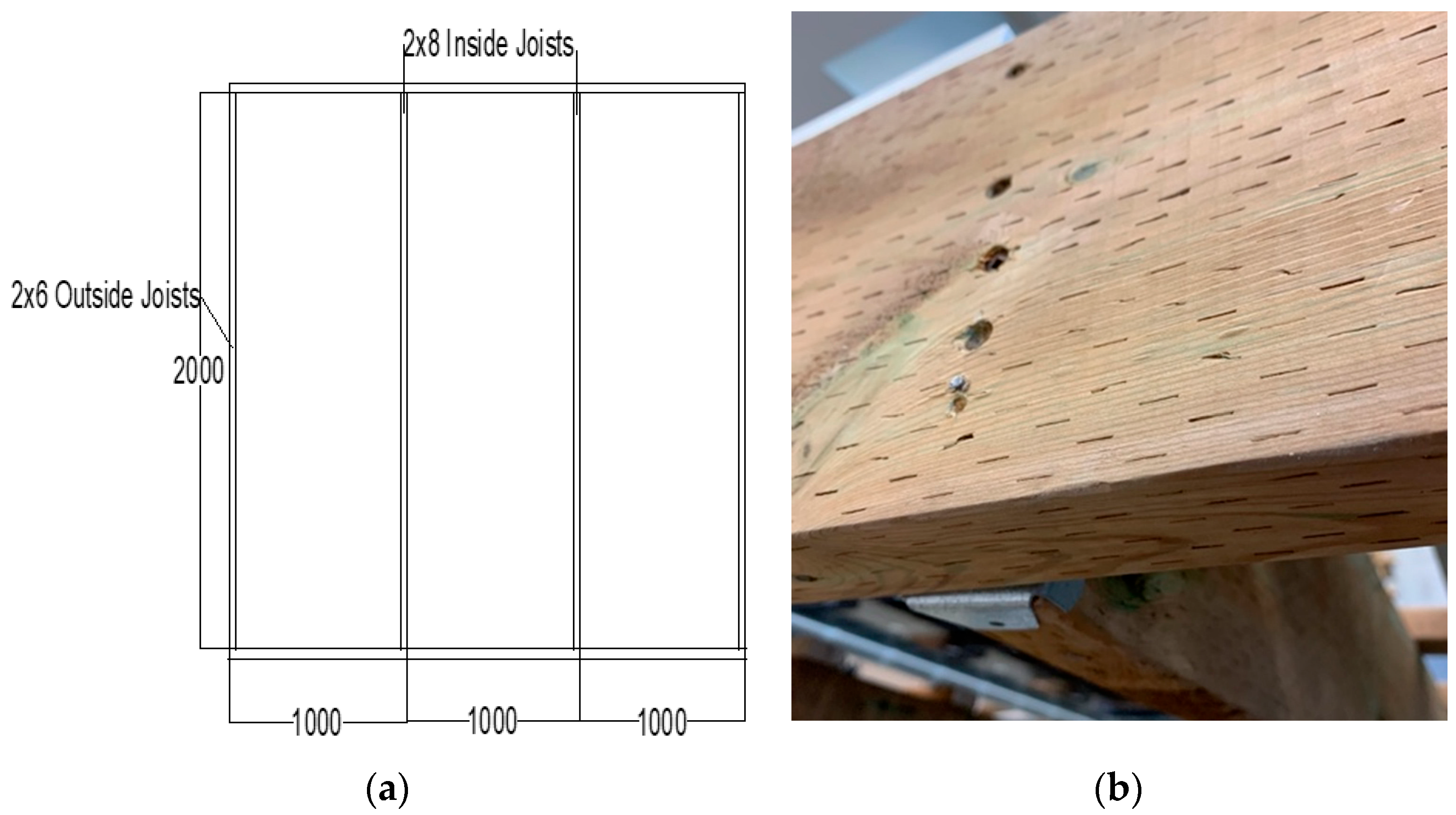


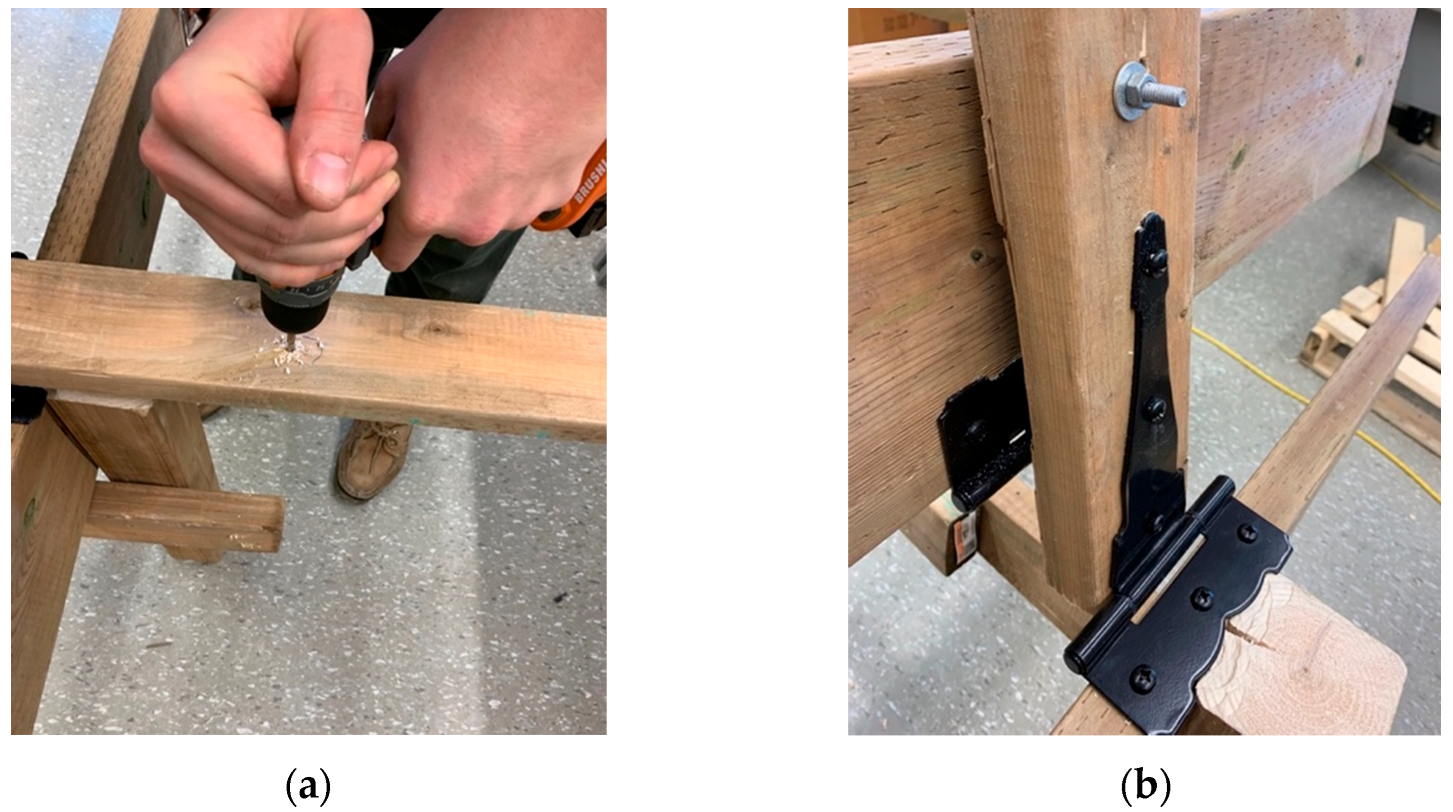
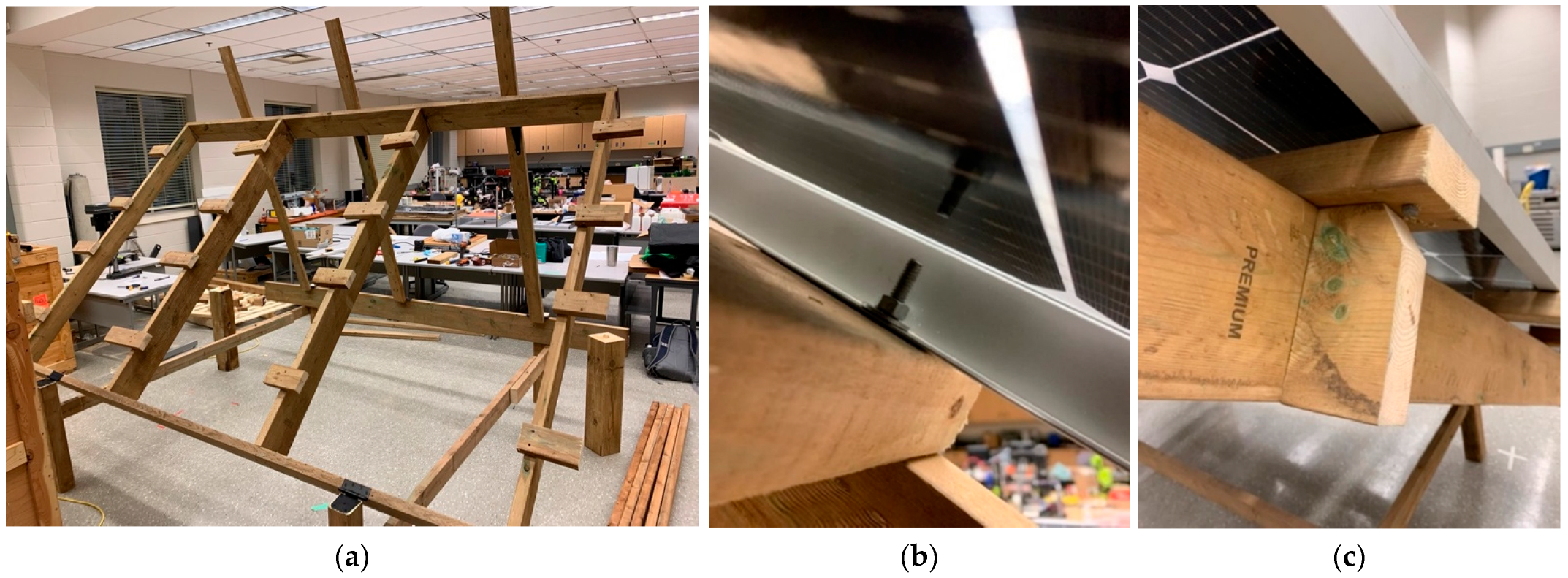

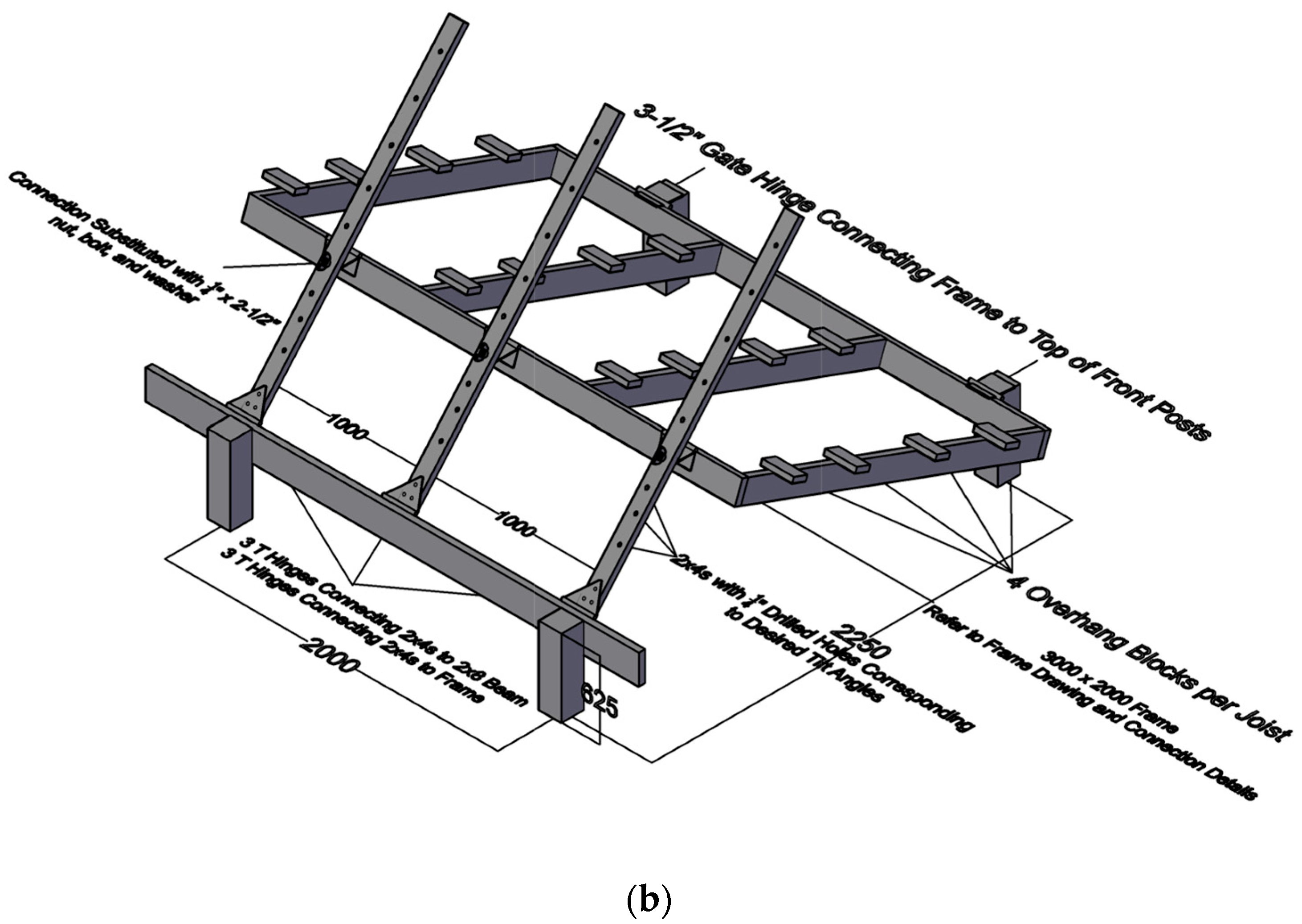
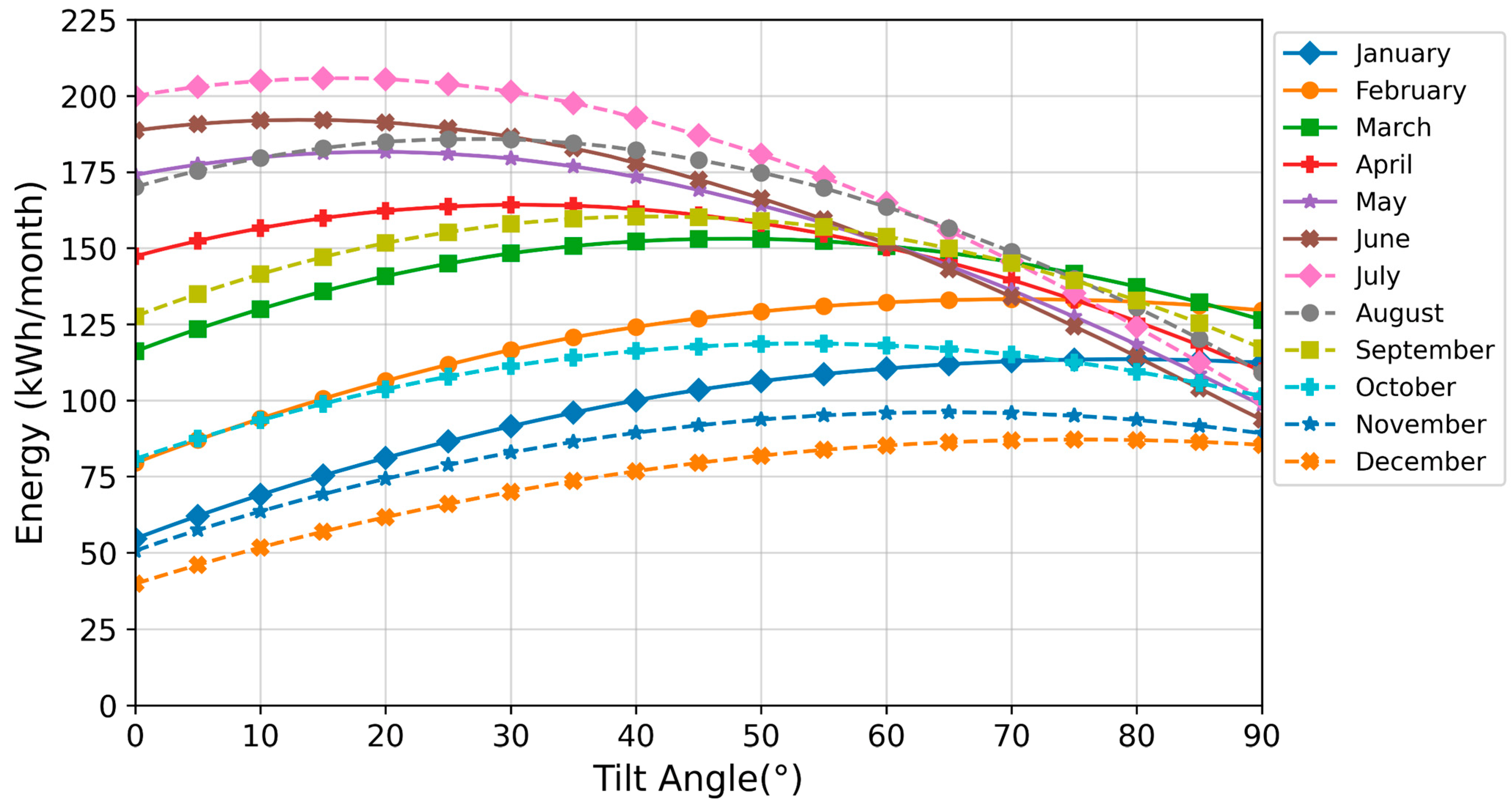
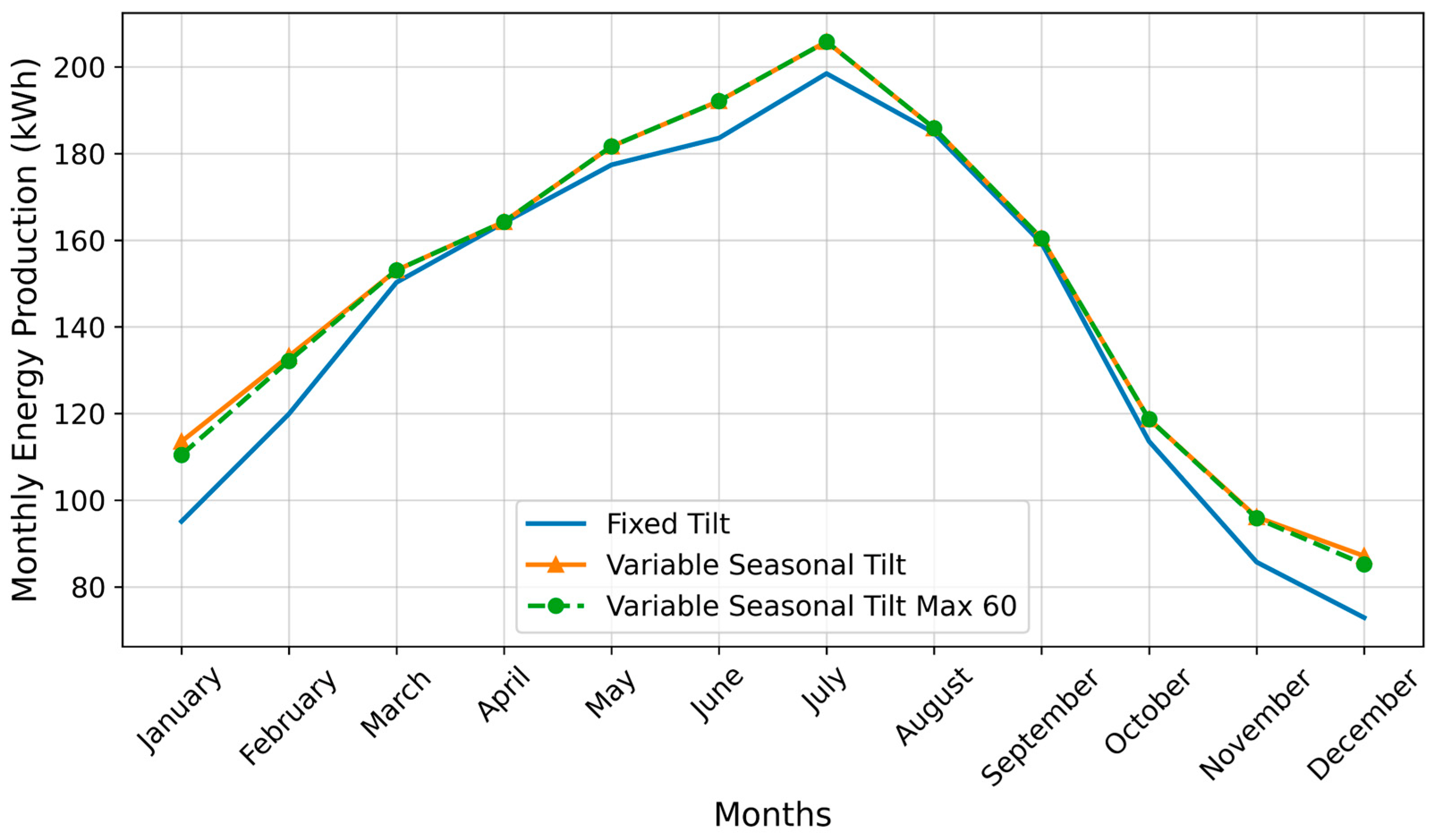
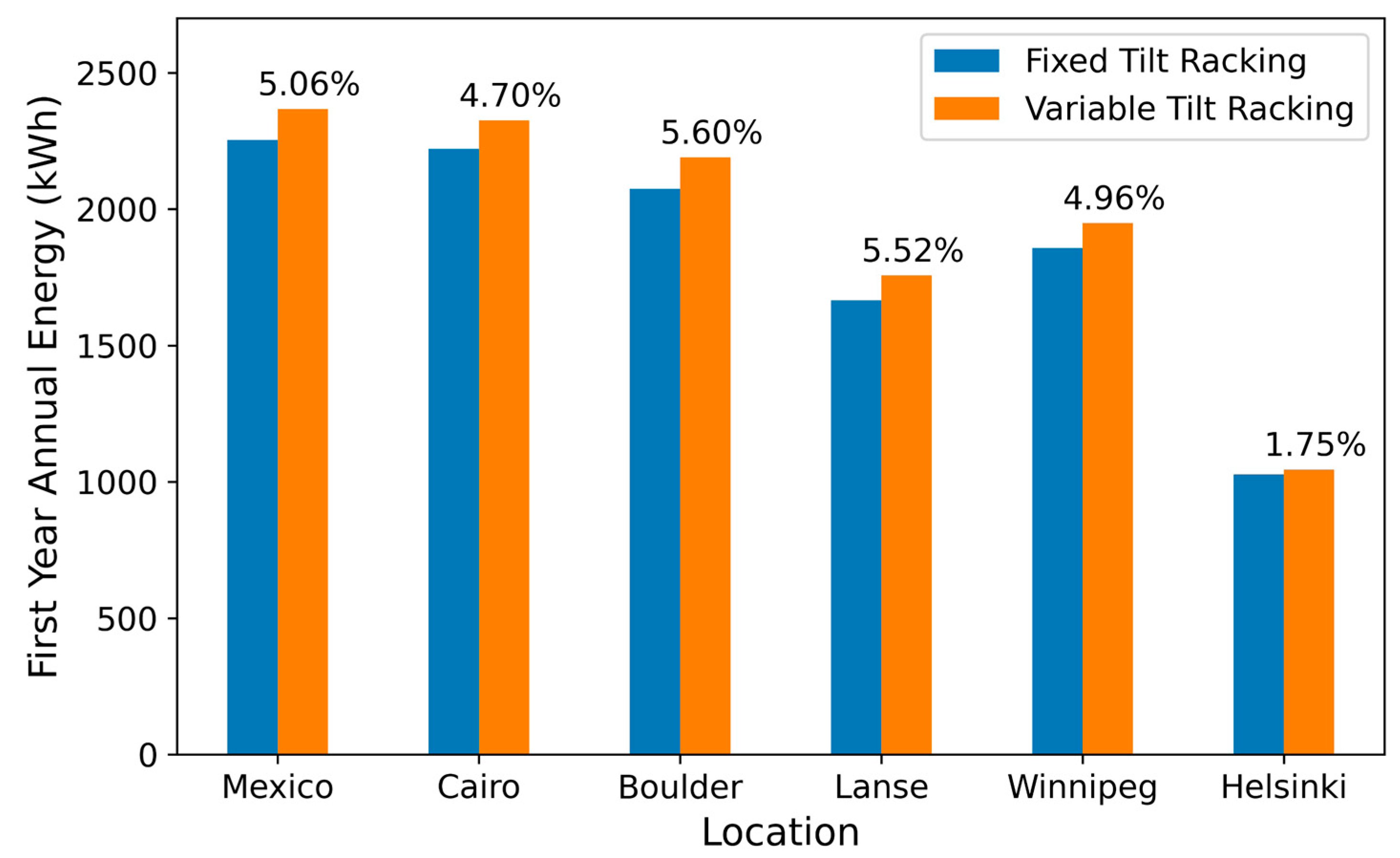
| System Parameter | Value |
|---|---|
| Modules DC Power (WDC) | 1200 |
| Inverter AC Power (WAC) | 1225 |
| DC to AC Ratio | 0.98 |
| Azimuth (°) | 180 |
| Lifetime (years) | 25 |
| Annual PV Degradation Rate (%) | 0.5 |
| Member Name | Piece 1 | Cost per Piece 2 | Quantity | Cost |
|---|---|---|---|---|
| Outside Joists | 2 × 6 × 8 | $16.12 | 2 | $32.24 |
| Inside Joists | 2 × 8 × 8 | $22.75 | 2 | $45.50 |
| Beams | 2 × 8 × 10 | $28.50 | 3 | $85.50 |
| Posts | 4 × 4 × 10 | $21.95 | 2 3 | $43.90 |
| Joist to Beam Connection | 2 × 4 Fence Bracket | $0.36 | 8 | $2.88 |
| Back Supports | 2 × 4 × 8 | $9.99 | 3 | $29.97 |
| 2 × 4 Hinges | 8″ Gate Hinges | $11.96 | 6 | $71.76 |
| 4 × 4 to Beam Hinges | 4″ Gate Hinges | $9.51 | 2 | $19.02 |
| Beam to Post Connection | 1/2″ Carriage Bolt (6″) Nut, & Washer | $4.44 4 | 2 | $8.88 |
| Tension Based Connections | 3″ Brown Deck Screws | $9.99 | 100 Pack | $9.99 |
| Shear Based Connections | 1-1/2″ Joist Hanger Nails | $3.62 | 1 lb | $3.62 |
| Module to Block Connections | 1/4″ Carriage Bolt (2-1/2″), Nut, and Washer | $0.48 4 | 27 | $12.96 |
| Total Cost with No Concrete | $366.22 | |||
| Concrete for Posts | 30 MPa Quikrete concrete | $4.98 | 8 bags | $39.84 |
| Total Cost: | $406.06 |
| Task | Typical Time to Complete 1 |
|---|---|
| Hole digging and post installation with temporary bracing | 3.0 h 2 |
| Frame Installation | 1.0 h |
| Back Support Drilling and Hinge Installation | 3.0 h |
| Block Installation | 0.5 h |
| Module Installation | 1.0 h |
| Total Time | 8.5 h |
| Tilt Angle (Degrees) | Typical Time Spent (Minutes) | Number of Workers |
|---|---|---|
| 0 to 35 | 3 | 2 |
| 35+ | 4 | 3 |
| Member Name | Shear (kN) | Moment (kNm) | Deflection (mm) | Tension/Compression (kN) |
|---|---|---|---|---|
| Outside Joists | 0.95 | 0.45 | 3.30 | N/A |
| Inside Joists | 1.90 | 0.90 | 1.65 | N/A |
| Beams | 1.90 | 0.50 | 2.73 | N/A |
| 2 × 4 Back Supports | N/A | N/A | N/A | −2.22 |
| Middle Back Support | N/A | N/A | N/A | −1.31 |
| Back Beam | 0.70 | 0.70 | 0.65 | N/A |
| Back Posts | 0.45 | 0.43 | 0.80 | −2.70 1 |
| Front Posts | 0.45 | 0.51 | 0.90 | −2.70 1 |
| Month | Optimal Tilt (°) | Maximum Energy Generation during the First Operational Year (kWh/Month) |
|---|---|---|
| January | 79 | 114 |
| February | 71 | 133 |
| March | 46 | 153 |
| April | 30 | 164 |
| May | 19 | 182 |
| June | 13 | 192 |
| July | 16 | 206 |
| August | 28 | 186 |
| September | 41 | 160 |
| October | 54 | 119 |
| November | 64 | 96 |
| December | 76 | 87 |
| Racking System (3 Modules) | Lifetime Energy (kWh) | Racking Cost (CAD) | LCOE (CAD/kWh) | Cost per W (CAD/W) |
|---|---|---|---|---|
| Wood Fixed Tilt [36] | 40,065 | 388.78 | 0.0097 | 0.32 |
| Wood Optimal Variable Tilt | 42,152 | 406.06 | 0.0096 | 0.34 |
| Wood Optimal Tilt with Max Angle Capped at 60° | 41,997 | 406.06 | 0.0097 | 0.34 |
| Metal Optimal Commercial Variable Tilt [46] | 42,152 | 1399.99 | 0.0332 | 1.17 |
| Cities | Mexico | Cairo | Boulder, Colorado | L’Anse | Winnipeg | Helsinki |
|---|---|---|---|---|---|---|
| Latitude (°) | 19.45 | 30.05 | 40 | 46.77 | 49.89 | 59.97 |
| Country | Price (USD) 1 | Source 2 |
|---|---|---|
| Canada | $8.46 | The Home Depot |
| USA | $9.68 | The Home Depot |
| Togo | $21.67 | Collected Locally |
| United Kingdom | $15.70 | B and Q |
| Netherlands | $10.32 | Woodvision |
| Australia | $13.92 | Bunnings |
| Brazil | $12.03 | Fremade Madeiras |
| India | $4.96 3 | IndiaMart |
| Application | System Size | Number of Systems Required | Additional Energy Generated over Lifetime |
|---|---|---|---|
| Base System | 1.2 kW | 1 | 1.93 MWh |
| Typical Residential Home in Ontario 1 | 7.2 kW | 6 | 11.58 MWh |
| Small Business 2 | 21.6 kW | 18 | 34.74 MWh |
| Agrivoltaics | 100 kW | 84 | 160.19 MWh |
Publisher’s Note: MDPI stays neutral with regard to jurisdictional claims in published maps and institutional affiliations. |
© 2022 by the authors. Licensee MDPI, Basel, Switzerland. This article is an open access article distributed under the terms and conditions of the Creative Commons Attribution (CC BY) license (https://creativecommons.org/licenses/by/4.0/).
Share and Cite
Vandewetering, N.; Hayibo, K.S.; Pearce, J.M. Open-Source Design and Economics of Manual Variable-Tilt Angle DIY Wood-Based Solar Photovoltaic Racking System. Designs 2022, 6, 54. https://doi.org/10.3390/designs6030054
Vandewetering N, Hayibo KS, Pearce JM. Open-Source Design and Economics of Manual Variable-Tilt Angle DIY Wood-Based Solar Photovoltaic Racking System. Designs. 2022; 6(3):54. https://doi.org/10.3390/designs6030054
Chicago/Turabian StyleVandewetering, Nicholas, Koami Soulemane Hayibo, and Joshua M. Pearce. 2022. "Open-Source Design and Economics of Manual Variable-Tilt Angle DIY Wood-Based Solar Photovoltaic Racking System" Designs 6, no. 3: 54. https://doi.org/10.3390/designs6030054
APA StyleVandewetering, N., Hayibo, K. S., & Pearce, J. M. (2022). Open-Source Design and Economics of Manual Variable-Tilt Angle DIY Wood-Based Solar Photovoltaic Racking System. Designs, 6(3), 54. https://doi.org/10.3390/designs6030054









